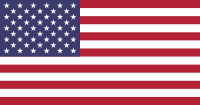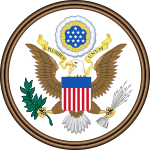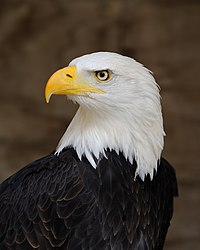
Every nation has symbols—specific objects that represent beliefs, values, traditions, or other intangible ideas that make that country unique. While these symbols may change over time, they can help to bind a nation together by reminding its people of their nation's history and most important principles.
1. National Flag - American Flag or US Flag
flag, consists of thirteen equal horizontal stripes of red (top and bottom) alternating with white, with a blue rectangle in the canton (referred to specifically as the "union") bearing fifty small stars.

2. National Seal - Great Seal of the US
The Great Seal is a principal national symbol of the United States.


3. National Bird - Bald Eagle
The bald eagle is a bird of prey found in North America.

4. National Animal - North American Bison
The American bison (Bison bison) is a species of bison native to North America

5. National Anthem - The Star-Spangled Banner
A national anthem is a patriotic musical composition symbolizing and evoking eulogies of the history and traditions of a country or nation. "The Star-Spangled Banner" is the national anthem of the United States.
6. National Flower - Rose
Different processes have been used to adopt these symbols – some are conferred by government bodies, whereas others are the result of informal public polls. the term state flower is more often used.

7. National Tree - Oak Tree
There are approximately 500 extant species of oaks.
1. National Flag - American Flag or US Flag
flag, consists of thirteen equal horizontal stripes of red (top and bottom) alternating with white, with a blue rectangle in the canton (referred to specifically as the "union") bearing fifty small stars.
2. National Seal - Great Seal of the US
The Great Seal is a principal national symbol of the United States.
3. National Bird - Bald Eagle
The bald eagle is a bird of prey found in North America.
4. National Animal - North American Bison
The American bison (Bison bison) is a species of bison native to North America
5. National Anthem - The Star-Spangled Banner
A national anthem is a patriotic musical composition symbolizing and evoking eulogies of the history and traditions of a country or nation. "The Star-Spangled Banner" is the national anthem of the United States.
6. National Flower - Rose
Different processes have been used to adopt these symbols – some are conferred by government bodies, whereas others are the result of informal public polls. the term state flower is more often used.
7. National Tree - Oak Tree
There are approximately 500 extant species of oaks.
8. National March - The Stars and Stripes Forever
"The Stars and Stripes Forever" is a patriotic American march written and composed by John Philip Sousa in 1896. By a 1987 act of the U.S. Congress, it is the official National March of the United States of America.
Reference: Wikipedia, Library of Congress
Information Shared by "Children's Park" Preschool in Rockwall.
Comments
Post a Comment